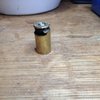JimGun
Member
I was on the gun range practicing double taps when this occurred to one of my cartridges. It is a Starline brass casing that has been used for a good while, but no signs of failure. e.g. cracks or white lines. The load was 5.2 grains of Winchester 231. the bullet, seated at 1.260", was a 230 grain Rainer.
I was shooting a new Kimber Tactical Custom HD II.
I am wondering if there is any way to determine if this is simply brass failure, or, due to the even way it blew out along the base, if it was fired out of battery. Any comments will be appreciated. I want to change what I can in order to prevent this from occurring again. It was somewhat nerve-racking.
I was shooting a new Kimber Tactical Custom HD II.
I am wondering if there is any way to determine if this is simply brass failure, or, due to the even way it blew out along the base, if it was fired out of battery. Any comments will be appreciated. I want to change what I can in order to prevent this from occurring again. It was somewhat nerve-racking.




